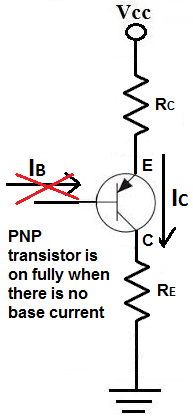Quick Q&A
Question: Why are PNP transistors referred to as "Normally On" Devices?
Answer:
PNP transistors are referred to as "Normally On" devices because when you connect a PNP transistor to a circuit, it conducts current across the emitter to collector, without any current necessary to be sourced to the base of the transistor. This means that the base doesn't need to have current flowing into it in order for the PNP transistor to be ON>
In other words, the PNP transistor conducts current across from emitter to collector without a current needing to be applied to the base. Instead when the base is connected to ground, current flows from the base to ground. This is why it is referred to as the "normally on" transistor. Instead of current flowing into the base of the PNP transistor, current is sinked from the base, meaning current flows out of the base. The base of the PNP simply needs to be connected to ground via a resistor.
So PNP transistors will normally conduct current from emitter to collector without any base current flowing into the transistor. Instead, by connecting the base to ground via a resistor, current flows out of the base, allowing for the operation of the PNP.
To shut it off or to stop current flow, a sufficient current must be applied to the base.
Only this active intervention shuts off the normally On state of PNP transistors.

This is in contrast to NPN transistors, which are referred to as "normally OFF"
devices. NPN transistors conduct current across the collector to emitter only with current applied
to the base of the transistor. And output current shuts off when the base current is removed.
